At first, there was the cable. No, that's wrong. First, there was the word, of course, and then the deed which resulted later in computers and other electronics - from super-clusters to mobiles. Then there rose the need for interaction among all this electronics. This is the way how the cable came into being, that is, first hard-wire interfaces. Then wireless, as technologies progressed. Leaving this long and sometimes heroic past of hard-wire networks outside the note, let's move on to the most interesting part - the current situation and the nearest future wireless prospects.
Separate Wi-Fi access points that could be plugged in to powerful backbone "hard-wire" networks, e.g. fiber-optical, were the first timid moves towards creation of wireless networks. Then there came up a new class of providers who deployed numerous commercial networks, thus in a matter of few years Wi-Fi networks turned into serious infrastructures - corporate and public. By now, many hotels, airports, and railway stations of the world have acquired Wi-Fi networks, and in some countries residential communities are covered this way.
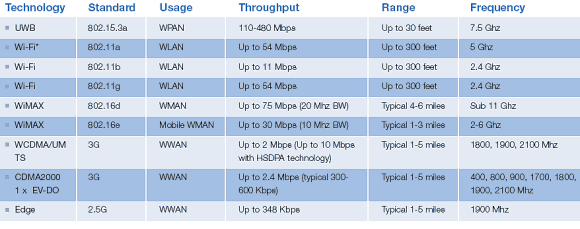
No doubt, introduction of Wi-Fi wireless networks has proved a revolutionary solution to the "last mile" problem. However, the standard's original limitations for data exchange rate and range, number of channels, high cost of the infrastructure have not yet made it possible for Wi-Fi to become a total threat to cellular networks on the one hand, and hard-wire networks, on the other. Even despite the substantial advantages and introduction of new, more up-to-date versions of the standard, the "native limitations" of Wi-Fi will be eliminated only through new backbone standards for data exchange. Sort of WiMAX.
WiMAX Definition
WiMAX stands for Worldwide Interoperability for Microwave Access, and is a technology of broadband wireless communication standardized by the IEEE which complements DSL lines and cable technologies as an alternative solution to the "last mile" problem at great distances. The WiMAX technology can be used to implement broadband "last mile" connections, deployment of wireless access point, arrangement of high-speed communication among company branches and solution of other similar tasks.
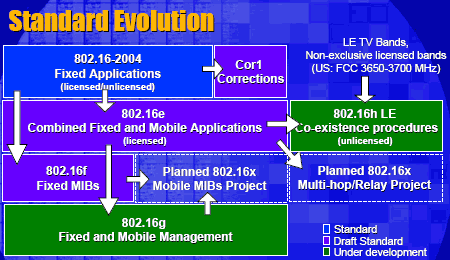
Evolution of WiMAX
The preliminary version of WiMAX provided functionality with the equipment which was not subject to standard tests for compatibility to the WiMAX technology. A number of service providers are still using such preliminary hardware solutions to implement WiMAX pilot projects in many parts of the world. Once tests for compatibility of these systems to the WiMAX technology are complete, they will most likely be upgraded programmatically in compliance with the requirements of the final WiMAX standard.
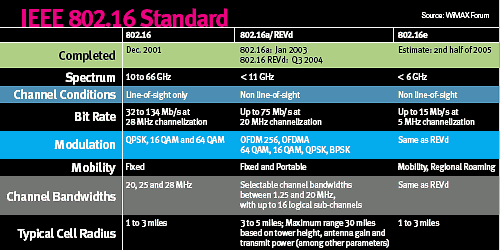
In ideal, the wireless technology WiMAX based on industrial standards is developed to provide inexpensive high-speed communication for residential areas, enterprises, and mobile networks in cities and in rural areas. Note the definition - it contains a "niche" for the interaction of backbone WiMAX with the "local" Wi-Fi.
Outlooks for WiMAX in the nearest future
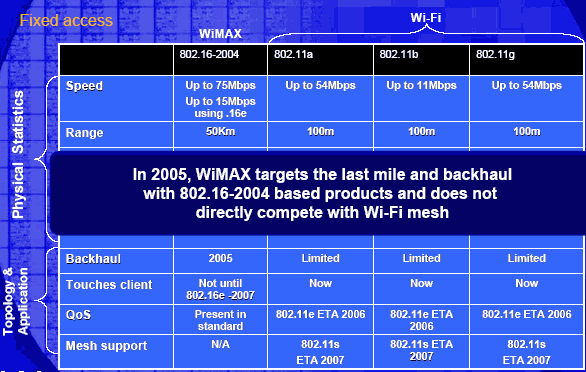
Today's WiMAX in the version IEEE 802.16-2004 is a standard of wireless communication, which provides broadband communication in the area of over 30 km in range with the bandwidth comparable to that for cable bonds - up to 10 Mbit/s and higher. The WiMAX technology allows operating in any conditions, including in the dense urban coverage, and providing a high quality of communications and data transmission rate.
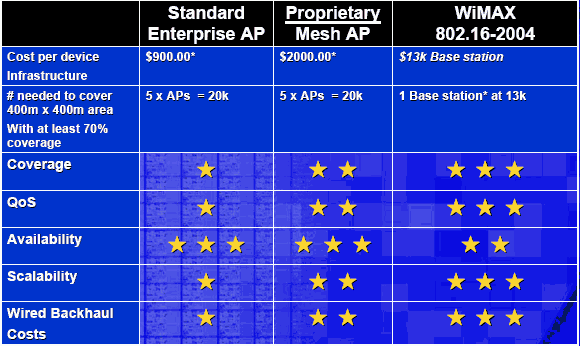
The equipment of WiMAX networks operates in several frequency channels of 10 MHz width within the range from 2 GHz to 11 GHz. Certainly, the specific distribution of frequency ranges in various countries calls for the need to operate WiMAX in various sectors. Such a wide discrepancy of ranges has been selected to cover the specifics of most countries of the world. For instance, in the North America the WiMAX uses sectors in the 2.5 and 5 GHz ranges, in the Central and South America - 2.5, 3.5, and 5 GHz, in the Middle East , Africa, Western and Eastern Europe - 3.5 and 5 GHz, in the Asian Pacific region - 2.3, 3.5, and 5 GHz.
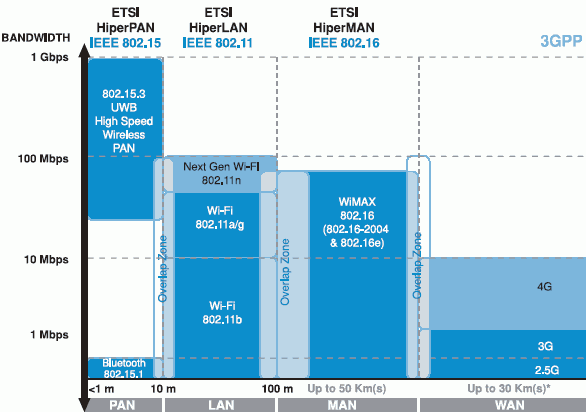
Essentially, WiMAX is a technology that provides access to Internet at T1 speed with the performance and coverage much higher than in modern Wi-Fi networks. In its turn, local Wi-Fi networks, various types of business and household cable/DSL networks of end users are just the continuation of WiMAX "backbone branches".
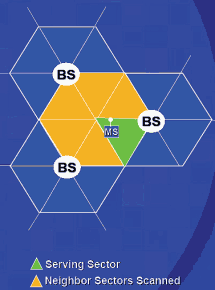
Establishing communications within 10 km range and farther, WiMAX points provide coverage of vast areas thus giving providers flexible enough conditions to ensure the very "last mile communication".
On the whole, the base characteristic of 802.16 standard provide a reach as far as 50 km, and coverage with the possible operation outside the direct visibility zone, which in prospect will give a peak data exchange rate up to 70 Mbit/s per sector, with the typical base station having up to coverage sectors.
Today, introduction of WiMAX is subdivided into the three main stages. The current first stage implies introduction and wide distribution of the WiMAX technology of EEE 802.16-2004 standard which came to replace the earlier versions IEEE 802.16a and 802.16d, and which uses external aerials of the "cellular disc" type aimed at consumers in fixed directions.
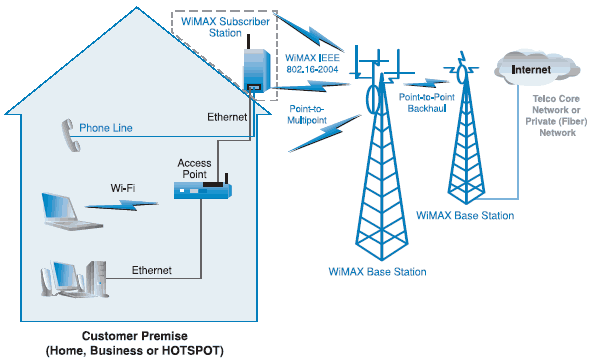
The second stage implies use of internal aerials, simplified and more flexible use of WiMAX to provide access.
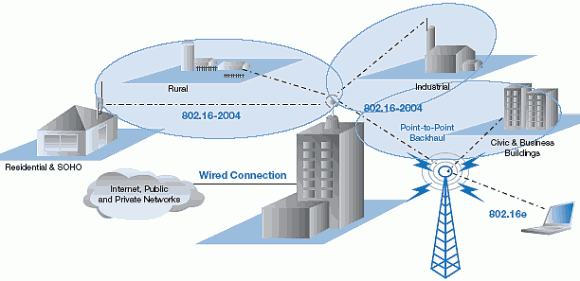
The third stage promises a wide introduction of IEEE 802.16e specifications whose ratification is expected in early 2006, and the emergence of first networks expected in 2007. That means the possibility for operating WiMAX-Certified solutions even as part of portable devices moving across the certain "coverage area" of the network, in the image and likeness of modern cellular and Wi-Fi networks.
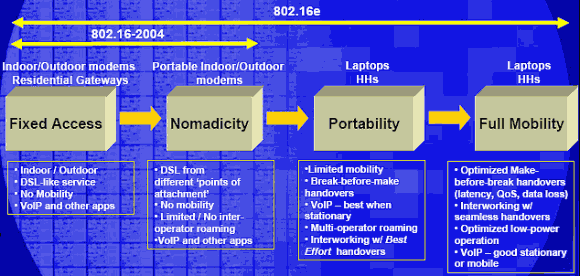
Development of such complex standards implies co-existence with other wireless standards, including cellular networks, development of new generations of "smart" aerials, application of new type of modulation like OFDMA, new types of services like QoS, data protection, and many other parameters. In this WiMAX review, we are not giving a detailed account of all the fine points of new standards, but in fact it is a long and painstaking process.
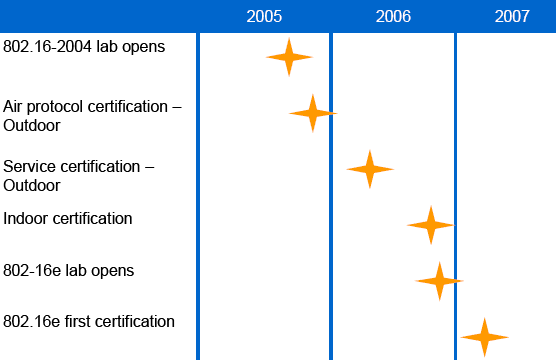
As regards the capabilities of the first-generation WiMAX - IEEE 802.16-2004, in ideal, each base station provides coverage within the range of up to 50 km at data exchange rate up to 35 Mbit/s. In practice, the width and respective performance of the channel is "sliced" for the end user by the service provider. But the way, the architecture of WiMAX networks which in ideal resembles honeycombs (but of a much larger "cell") implies placing antenna-feeder devices on high buildings, structures, and masts. No wonder that interest to the deployment of WiMAX networks was shown primarily by cellular network providers: however strong the competition between WiMAX and 3G/4G networks is, it is much cheaper to install and service several types of equipment on the same mast rather than on several ones. In any case, it is up to the consumer to decide whether to give preference to a specific network.
Today, maximum attention to the introduction of WiMAX networks is paid in the countries of vast territories and great distances from cities, as well as high percentage of rural population. Even for the most developed countries like Sweden it is of advantage to introduce WiMAX as an alternative to hard-wire backbone communications, GSM/EDGE and 3G networks. Needless to say, developing countries like China, India, and Russia will have to start from scratch.
